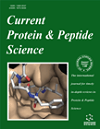- Home
- A-Z Publications
- Current Protein and Peptide Science
- Previous Issues
- Volume 17, Issue 3, 2016
Current Protein and Peptide Science - Volume 17, Issue 3, 2016
Volume 17, Issue 3, 2016
-
-
Pyrazinamide and Pyrazinoic Acid Derivatives Directed to Mycobacterial Enzymes Against Tuberculosis
More LessAuthors: Michelle Fidelis Corrêa and João Paulo-dos Santos FernandesTuberculosis (TB) is an infectious diseases responsible for thousands of deaths worldwide. Due to the use of antimycobacterial drugs, TB prevalence seemed to be controlled, but with the appearance of resistant tuberculosis cases, the concern about the disease had become significant again, as well as the need for new alternatives to TB treatment. Since pyrazinamide (PZA) is part of the firstline agents in TB treatment, several d Read More
-
-
-
Multi-output Model with Box-Jenkins Operators of Quadratic Indices for Prediction of Malaria and Cancer Inhibitors Targeting Ubiquitin- Proteasome Pathway (UPP) Proteins
More LessThe ubiquitin-proteasome pathway (UPP) is the primary degradation system of short-lived regulatory proteins. Cellular processes such as the cell cycle, signal transduction, gene expression, DNA repair and apoptosis are regulated by this UPP and dysfunctions in this system have important implications in the development of cancer, neurodegenerative, cardiac and other human pathologies. UPP seems also to be very import Read More
-
-
-
Significance of Lipolytic Enzymes in Pathogenesis and Treatment of Neglected Diseases
More LessAuthors: Debamitra Chakravorty and Sanjukta PatraNeglected diseases are infectious diseases that affect poor people of tropical countries. Drug resistance, lower availability of funds and research hinder the opportunities for the development of new drugs. The need for new drugs will persist until pathogens are eradicated. This calls for understanding the disease prognosis to initiate research for new drug targets and thus development of new drugs. As drug development Read More
-
-
-
Enzymatic Targets in Trypanosoma brucei
More LessAuthors: Luciana Scotti, Francisco J.B. Mendonça, Marcelo S. da Silva and Marcus T. ScottiOne of the most neglected disease is the Sleeping sickness or Human African Trypanosomiasis (HAT), which is mostly restricted to poor regions of Africa. The disease is caused by parasitic infection with Trypanosoma brucei (T. brucei), and is acquired through the bite of the tsetse fly. In the first stage of the disease, the parasite is in the blood, but in stage 2, the infective form reaches the brain, causing great weakness and death Read More
-
-
-
Targeting Plasmodium Metabolism to Improve Antimalarial Drug Design
More LessAuthors: Claudia Avitia-Domínguez, Erick Sierra-Campos, Irene Betancourt-Conde, Miriam Aguirre-Raudry, Alejandra Vázquez-Raygoza, Artemisa Luevano-De la Cruz, Alejandro Favela-Candia, Marie Sarabia-Sanchez, Lluvia Ríos-Soto, Edna Méndez-Hernández, Jorge Cisneros-Martínez, Marcelo Gómez Palacio-Gastélum, Mónica Valdez-Solana, Jessica Hernández-Rivera, Jaime De Lira-Sánchez, Mara Campos-Almazán and Alfredo Téllez-ValenciaMalaria is one of the main infectious diseases in tropical developing countries and represents high morbidity and mortality rates nowadays. The principal etiological agent P. falciparum is transmitted through the bite of the female Anopheles mosquito. The issue has escalated due to the emergence of resistant strains to most of the antimalarials used for the treatment including Chloroquine, Sulfadoxine-Pyrimethamine, a Read More
-
-
-
Drug Discovery and Development of Antimalarial Agents: Recent Advances
More LessAuthors: Sreekanth Thota and Rajeshwar YerraMalaria, a deadly infectious parasitic disease, is a major issue of public health in the world today and already produces serious economic constraints in the endemic countries. Most of the malarial infections and deaths are due to Plasmodium falciparum and Plasmodium vivax species. The recent emergence of resistance necessitates the search for new antimalarial drugs, which overcome the resistance and act throug Read More
-
-
-
Metabolic Enzymes of Helminth Parasites: Potential as Drug Targets
More LessMetabolic pathways that extract energy from carbon compounds are essential for an organism’s survival. Therefore, inhibition of enzymes in these pathways represents a potential therapeutic strategy to combat parasitic infections. However, the high degree of similarity between host and parasite enzymes makes this strategy potentially difficult. Nevertheless, several existing drugs to treat infections by parasitic helminths ( Read More
-
Volumes & issues
-
Volume 26 (2025)
-
Volume 25 (2024)
-
Volume 24 (2023)
-
Volume 23 (2022)
-
Volume 22 (2021)
-
Volume 21 (2020)
-
Volume 20 (2019)
-
Volume 19 (2018)
-
Volume 18 (2017)
-
Volume 17 (2016)
-
Volume 16 (2015)
-
Volume 15 (2014)
-
Volume 14 (2013)
-
Volume 13 (2012)
-
Volume 12 (2011)
-
Volume 11 (2010)
-
Volume 10 (2009)
-
Volume 9 (2008)
-
Volume 8 (2007)
-
Volume 7 (2006)
-
Volume 6 (2005)
-
Volume 5 (2004)
-
Volume 4 (2003)
-
Volume 3 (2002)
-
Volume 2 (2001)
-
Volume 1 (2000)
Most Read This Month
Article
content/journals/cpps
Journal
10
5
false
en


